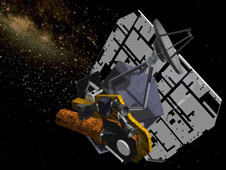Weirdly, that title is not as big a stretch as you might think.
NASA’s Deep Impact space probe slammed a large copper block into a comet back in July, 2005. However, the probe sailed on, and astronomers hate to waste a good thing. So the mission was retooled, and split into two major projects: for the Deep Impact Extended Investigation (DIXI) it will continue on to observe another comet called Hartley 2, and for the EPOCh component (Extrasolar Planet Observation and Characterization) it will observe planets around other stars.
The combined mission is now called EPOXI.
 The comet rendezvous isn’t until 2010. Until then, EPOXI will be used to carefully observe some stars known to have massive planets. These extrasolar planets (or exoplanets for short) were discovered using ground-based telescopes. Hundreds of planets orbiting other sunlike stars have been found since the first was discovered in 1995, but some are special: as seen from Earth, they pass directly between us and their parent star. These are called transiting planets, and some 33 are known at the moment.
The comet rendezvous isn’t until 2010. Until then, EPOXI will be used to carefully observe some stars known to have massive planets. These extrasolar planets (or exoplanets for short) were discovered using ground-based telescopes. Hundreds of planets orbiting other sunlike stars have been found since the first was discovered in 1995, but some are special: as seen from Earth, they pass directly between us and their parent star. These are called transiting planets, and some 33 are known at the moment.
Solar systems are like DVDs: wide but flat. If we see them edge-on, then a planet will pass directly in front of the star every orbit. That’s a transit.
A transit makes a fantastic resource for learning about other planets. Using some relatively simple math, you can get so much information from observing transits: the physical sizes of both the planet and its star, the planet’s density, and even (potentially) whether it has moons and the composition of its atmosphere. And all this can be done without ever having directly seen the planet! The way the light from the star dips as the planet passes in front of it tells us all this information, and more.
EPOXI is in a prime location to do this kind of observation. For one, it’s in space, so Earth’s atmosphere doesn’t muck up the view. Second, it really has nothing better to do then sit and stare at a star for weeks at a time, and that is a huge advantage*. The more transits you see, the better you can analyze them. Also, if there is one transiting planet, there are likely to be more. Remember the DVD analogy above? Seen edge-on, the odds are good that other planets in the system will transit their star, but smaller planets make smaller dips in the starlight, making them difficult to see from Earth. EPOXI may be able to detect lower-amplitude transits like that. It will observe five different stars known to have transiting planets, looking for smaller planets, moons around the bigger ones, and other cool things.
I love this idea. Exoplanets are a fascinating subject, and they make up a field of science that has literally only been around a few years. Some transits can be observed using a backyard telescope! But the view from space is a lot better… and launch costs are pricey. Reusing an existing mission to do new science is an excellent use of resources, and a fantastic way to breathe new life into an older project.
*And the reason I titled this post the way I did.